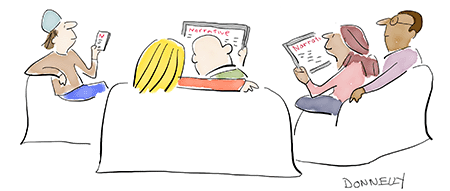An Interview
Alan Ziegler’s office, reached through the busy headquarters of Columbia University’s legendary graduate programs in writing, opens via enormous two-story windows onto a scene of university grandeur: the central plaza of the main campus, with the halls of art history and philosophy across the way, and the long procession of steps up to Low Memorial Library glowing granite and cold. On the November afternoon I met him, the formality of the view suggested a certain gravitas, a hush.
But inside Ziegler’s office, every surface is covered with stuff. The space houses several collections: fountain pens in special stands, a row of tiny model typewriters, photographs Ziegler took on holiday in Tuscany, various figurines, the silver clerk’s bell that belonged to his father when he worked in a motel, books. It is a tinkerer’s space, a workshop in the craftsman’s sense. Often, as he spoke, Ziegler got up from his chair and rummaged around the room, looking for objects related to his stories, pulling books from the shelves, ringing the clerk’s bell.
The office wall opposite the high windows is covered top to bottom in framed photographs, with the notable exception of one small tacked-up print, placed high and to the left, at the heart of the display: Courbet’s 1848 portrait of Baudelaire. The young poet is bent over an open book, one hand braced on cushions in the foreground, the quill in its well. It is a rich and solemn image. Ziegler has surrounded the print on all sides with a wide array of elegantly matted and framed, vivid portraits of a small dachshund. This is his dog, Latte, and she is well loved. Ziegler has pictures of Latte the way other people have pictures of animals on safari: Latte running across an open field, ears aloft, sun streaming; Latte in close-up, sniffing the wind; Latte in repose. The author of Les Fleurs du Mal is almost, but not quite, lost in the display.



